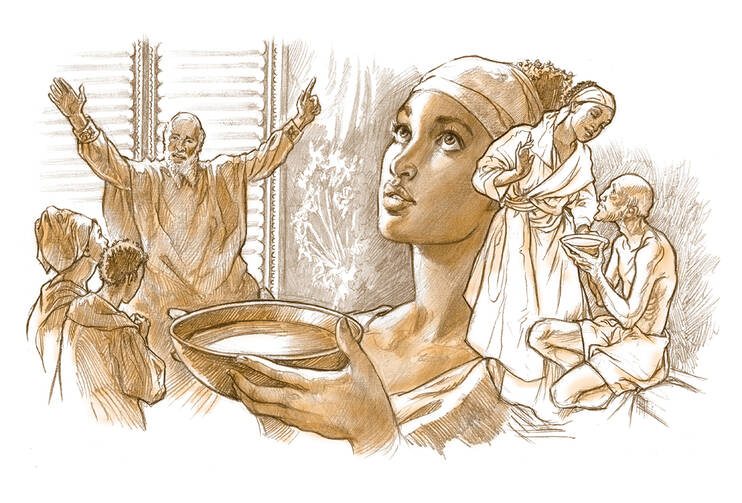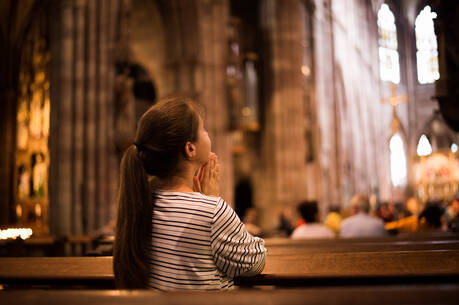In order to appreciate the racial divide in the United States, I would like to do something rather unusual. It requires white Catholics to use their imagination in order to enter into the role-reversal presented in the narrative that follows. The narrative portrays an imagined Catholic Church in the United States in which most American Catholics are people of color and white Catholics are members of a very small minority group.
Imagine yourself as a white American teenager living in a poor urban area with few opportunities for you to get a good education and find meaningful employment. Imagine that some of your friends are troublemakers, and when the African-American police come around they often intimidate them. This frightens you because another white friend of yours was shot and killed by African-American police officers when he reached into his pocket for his wallet, which they thought was a gun. Since you were very young, your parents have cautioned you to avoid contact with the police because they may suspect you of wrongdoing.
You and your friends, whose families are struggling to make ends meet, live near the neighborhood Catholic church. You have never been inside the church. You and your family are not members of the Catholic Church, which some of your relatives call a “black racist institution” that traditionally has not shown much interest in inviting white people to join the parish. As a matter of fact, when some white people visited the church for Mass, they were largely ignored and made to feel unwelcome. You and your friends feel that a church that promises the joy of eternal life after you die while offering little to help in your daily struggles is not very meaningful. As a white youth having a hard time with life, you want a church that will be at your side, engaged in the struggle, helping you find a God of the oppressed and an angel of freedom and justice. You want a church that embraces, celebrates and is informed by the “white experience.” If God is to really be God for you, he must be God the liberator, who uproots injustice and oppression by his mighty power. For you and your friends, a God of the status quo is dead.
Now imagine that an African-American acquaintance, sensing that you are discouraged, persuades you to go with him to this very church, St. Charles Lwanga, for Mass. You enter the church, and the first thing you notice is that all images of the sacred are in Afro-centric art. All images of Jesus, Mary, Joseph and all the saints are as people of color (African, Hispanic, Asian or Native American). God the Father himself is painted on the ceiling of the church as a distinguished older black gentleman. You think to yourself, “God the Father is absolute spirit. He has no race or nationality or anatomical gender. Scripture never describes him as an elderly, African-looking, brown-skinned man.” You wonder if the Catholic Church believes that only people of African ancestry are in heaven.
You notice that even the angels in the church have African features. If angels have no bodies and no gender, if they are pure spirits, why are they not represented in all races? Just think of the impact it would have on unchurched white people, like you, if they encountered the image of a magnificent white angel with blond hair and blue eyes when they entered a Catholic church. You also notice that in the Catholic Church, “black” symbolizes everything that is good and holy whereas “white” symbolizes evil, sin and death. The images of Satan, devils and demons in the church are all white. Later, you search art books and cannot find one image of Satan painted in dark hues. He is always depicted in light, pale, radiant white colors.
You ask your African-American acquaintance, “Wouldn’t the Catholic Church be more truly universal and welcoming of all if the holy men and women of the Bible were pictured as people of different ethnic and racial backgrounds? After all, though we know they were Jewish, no one knows what they actually looked like. Semitic people do not all look like western Europeans.” He responds: “That question has been asked before, and the response has usually been that people who are white should realize that the Afro-centric art represents them as well. Afro-centric art is universal. It represents all people. Furthermore, everyone realizes that the all-black religious art is found in Catholic churches for historical reasons. Even though a few churches have added a white saint here and there, for the most part the few white Catholics we have in the church have simply accepted the fact that the majority of churches have few or no images of the citizens of heaven who look like them.”
You ask your acquaintance, “Does the Catholic Church intend to perpetuate this all-black image of heaven in the churches of the future?” Your African-American acquaintance replies, “There are a few churches in big cities with a large number of ‘minorities’ where they have painted white angels and saints. But some of the older white people don’t like it. They say they do not believe God looks like them. They also say that the dense, impenetrable darkness of blackness better expresses the deep mystery of God, who dwells in unapproachable night. These white people point out that in many countries where most of the people are European, the people almost never complain about the all-African religious art. They seem to appreciate that black really is beautiful.”
“But,” you ask, “what about here in the racially diverse United States? What a powerful statement the Catholic Church would make if it mandated all future churches to have racially diverse images of God, Jesus, Mary, saints and angels? Wouldn’t this convey a more authentically universal image of heaven? Wouldn’t that be a small bridge for crossing the racial divide that continues to undermine the catholicity of the church?” Your African-American acquaintance answers, “I think I understand the point you are trying to make. But, I really don’t think that is ever going to happen.”
“Why not?” you ask. “Why not?”










